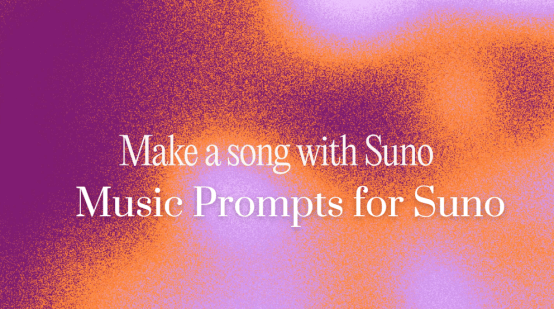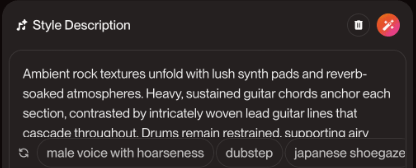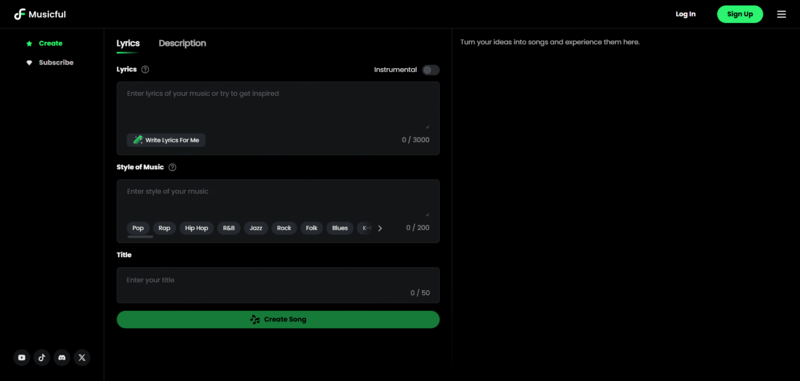Jul 08, 2025
4 min read
Stuck staring at the prompt box in Suno, wondering what to type? You're not alone—and the truth is, a great Suno song starts with a great prompt.
This guide gives you 50+ ready-to-use Suno prompts, covering all styles, moods, and creative directions.

From genre-based templates to lyrics-driven suggestions, this is your go-to Suno prompt guide to spark inspiration, save time, and create music that actually sounds like you.
Part 1: What Are Suno AI Prompts?
A Suno AI prompt is a set of instructions or keywords that guide the AI in making music. It tells Suno AI what kind of song you want, the mood you’re aiming for, and the instruments you’d like to hear. Think of it as giving directions to a skilled musical partner who turns words into tracks.
A well-structured prompt acts like a roadmap, leading Suno AI to create music that fits your idea. If you want more control, Suno AI offers a "Custom Mode." This lets you fine-tune lyrics and musical style for a more personal touch.
Part 2: Components of a Good Suno Prompt
To create great music with Suno AI, it's important to understand the key parts of a good prompt.
Genre/Style: The musical category or type of music. This sets the overall feel of the song. Whether it's pop, rock, jazz, or electronic, picking a genre helps Suno AI understand your musical direction.
Mood/Emotion: The feeling or atmosphere the music should evoke. Words like "happy," "melancholic," or "energetic" guide the AI in setting the right tone.
Instrumentation: Mentioning key instruments helps to shape the sonic palette of the generated music.You can specify instruments like piano, electric guitar, or orchestral strings to refine the sound.
Tempo/Rhythm: The speed and rhythmic feel of the music.You can use terms like "fast-paced" or even a specific BPM.
Vocal Preferences: Characteristics of the vocals, such as tone and singer type.
Structure tags: The organization of different musical sections. Such as [Intro] or [Chorus]....,etc.
Part 3: How to Craft Better Suno Prompts?
Want more consistent, high-quality music from Suno? The secret isn’t just the model—it’s how you write your prompt. Here’s how to reduce randomness and get results that match your vision.

1. Mistakes to Avoid When Writing Suno Prompts
Even small errors in your prompt can throw the output off. Avoid these common issues:
• Being too vague - Generic prompts lead to uninspired music. Instead of "happy song", try "upbeat pop with catchy melodies".
• Overloading with details - Too much information can confuse the AI. Keep the prompts clear and focused.
• Ignoring key elements - Specify tempo, mood and instruments for better results.
• Not refining prompts - Adjust and experiment rather than expecting perfection on the first try.
• Using overly complex terms - Keep descriptions simple and clear.
• Neglecting meta tags - Use tags like "[verse]" and "[chorus]" for structured songs.
2. Advanced Suno Prompting Tips (For Pro Users)
Pro Tips 1: Use the Prompt Booster (Pro only)
In V4.5, after typing your prompt, tap the ✨ icon at the top-right. This enhances your prompt with extra creative elements, helping Suno deliver more dynamic results.
Before click:

After click:

Pro Tips 2: Start Your Lyrics with Sound Design Tags
Adding mixing and mastering descriptors at the start of your lyrics can influence the audio quality.
Try using tags like:
• [High-fidelity stereo sound with wide spatial imaging]
• [Crisp mix and polished mastering]
• [Warmth from vintage analog compression]
Pro Tips 3: Describe Your Song as a Story
Think about the narrative or emotional journey of the song.
Example: A nostalgic electronic ballad about growing up, starting soft and slow, building to a powerful chorus with layered vocals.
Pro Tips 4: Use Punctuation to Guide Suno’s Creativity
• [Brackets] – Highlight Important Elements
Use square brackets to signal the core ingredients of your track while still letting Suno stay creative. You’re basically saying, “These are the priorities—use them, but feel free to adapt.”
Example: [synth pads, electronic drums, deep bass]
• Colons (:) – Assign Values Clearly
Colons are useful when you want to give specific instructions for structure, mood, or settings. It helps Suno break down your prompt into readable categories.
Example: Mood: euphoric / BPM: 122 / Instrument: electric guitar
• (Parentheses) – Add Subtle Detail
Use parentheses to insert fine-tuned instructions—like how something should sound or be performed. Think of this as whispering an extra tip to the AI.
Example: Include harmonies (soft and breathy, with reverb)
• Slashes ( / ) – Offer Flexible Options
Can’t decide between two sounds? Use slashes to give Suno a menu of choices. It might pick one or combine both based on the flow.
Example: Add a solo with violin/guitar
• Quotation Marks (" ") – Lock in Exact Words
Quotation marks tell Suno, “Use this text exactly as it is.” Great for lyrics, dialogue, or spoken word moments.
Example: Include a line that says, "I’ve seen the future and it’s glowing"
• Ellipses (…) – Let Suno Improvise
Ellipses are your go-to when you want Suno to fill in the blanks. Perfect for intros, outros, and anything you want to leave open-ended.
Example: End the track with a dreamy synth outro…
Part 4: Best Prompts for Suno to Copy and Use
1. Suno Prompts by Style, Mood, Instrument & Experimental
Genre-Specific Suno Prompts
Guide Suno to focus on particular music genres.
-
"Compose a soothing lo-fi track for studying."
-
"Generate a retro 80s synthwave instrumental."
-
"Make a modern K-pop dance track with strong rhythm and catchy hooks."
-
"Create a melancholic indie folk song with acoustic textures."
-
"Write a reggae track with island drums and laid-back guitar."
-
"Create a boom bap hip-hop beat with sampled horns and scratches."
Mood-Focused Suno Prompts
Direct the AI to produce music that evokes a specific feeling.
-
"Create a sad song with soft piano and emotional lyrics."
-
"Produce an uplifting orchestral piece for a motivational video."
-
"Make a dark, moody trap beat with tension and atmosphere."
-
"Make an inspiring orchestral piece that builds hope and motivation."
-
"Generate an energetic EDM festival anthem."
-
"Produce a confident rap beat with swagger and bounce."
Instrument-Based Suno Prompts
Highlight specific instruments to shape your track’s core sound.
-
"Compose a piece of jazz music led by a saxophone."
-
"Focus on acoustic guitar for a soulful folk melody."
-
"Create an EDM track with driving synth leads and 808 bass."
-
"Make an electronic track with modular synths and analog warmth."
-
"Write a blues track led by electric guitar and soulful bends."
-
"Compose a chillwave track with plucky synths and ambient textures."
Experimental Suno Prompts
Encourage Suno to combine styles or experiment with sounds.
-
"Blend elements of classical music with modern trap beats."
-
"Create an ambient track inspired by futuristic sci-fi themes."
-
"Mash up reggae rhythms with funk guitar and hip-hop vocals."
-
"Write a song that evolves from lo-fi beats into epic cinematic build-up."
-
"Generate a cinematic trap anthem with epic brass and choral samples."
-
"Compose a synthwave track layered over traditional Chinese instruments."
2. Suno Prompts Examples with Output
Simple Suno Prompts Examples for Beginners
-
"Make a happy pop tune with catchy lyrics."
-
"Generate a relaxing background track with soft piano and chords."
-
"Write a chill hip-hop beat with smooth grooves."
-
"Create a romantic ballad with a slow tempo and emotional melody."
Advanced Suno Prompts for Experienced Users
-
"Produce a cinematic score with dramatic crescendos and a choir."
-
"Compose a progressive rock piece with dynamic tempo changes."
-
"Create a jazz fusion track with complex chord progressions and layered rhythms."
-
"Write an electronic song with ambient intro, evolving basslines, and glitchy effects."
Community-Inspired Suno Prompts
-
"Write a playful melody inspired by classic video game soundtracks."
-
"Create an atmospheric track for meditation and mindfulness."
-
"Compose a dramatic theme song for a fantasy anime series."
-
"Make a high-energy dance track perfect for TikTok reels."
TikTok-Ready & Viral Suno Prompts
-
"Create a sped-up pop remix with distorted vocals."
-
"Produce a lo-fi background loop with aesthetic vibes."
-
"Make a catchy 15-second beat drop for a dance challenge."
-
"Compose a nostalgic 2000s ringtone-style melody."
Lyrics-Driven Suno Prompts
-
"Compose a duet between two characters falling in love."
-
"Generate a rock song about rebellion and youth."
-
"Create a heartfelt ballad from the perspective of a lonely astronaut."
-
"Write a piano ballad about forgiving someone who hurt you."
Use-Case-Based Suno Prompts
-
"Create a chill intro track for a YouTube vlog."
-
"Generate an uplifting background loop for a travel montage."
-
"Make a retro video game soundtrack for an 8-bit adventure."
-
"Make a cute ukulele tune for a kids’ story animation."
With these examples, you can experiment and refine your own Suno style prompts to achieve stunning results!
Part 5:FAQ about Suno AI Prompts
1. How to write good prompts for Suno AI?
To write effective Suno prompts, be specific and clear about your expectations.
-
Include genre: "Create a calming lo-fi track."
-
Define the mood: "Compose an uplifting orchestral piece."
-
Specify instruments: "Focus on acoustic guitar with subtle drums." Good prompts combine these elements to give the AI precise instructions.
2. What are good AI prompts?
Good AI prompts are:
-
Concise: Avoid long, overly detailed instructions.
-
Specific: Clearly mention style, instruments, or emotion.
-
Action-Oriented: Use verbs like compose, generate, or create.
Examples:
-
"Generate a suspenseful track with deep bass."
-
"Compose an upbeat acoustic folk melody with a lively tempo."
3. How to get the best results with Suno?
-
Experiment and Iterate: Start with simple prompts and gradually add details to refine the output.
-
Use Examples: Reference a song or style for the AI to emulate.
-
Leverage Community Ideas: Check platforms like Reddit for tried-and-tested prompts shared by other users.
Bonus: Discover a Great Suno AI Alternative
Suno is excellent for generating music ideas from simple prompts. But exploring Suno alternatives can expand your creative potential.
One standout option is Musicful. If you're looking to turn your lyrics into full songs, or want more control over vocals, flow, and structure, it might be exactly what you need.

Musicful is not here to replace Suno—but to go deeper into full-track creation. It’s ideal for artists who want to shape songs from lyrics, imitate a flow they love, or generate music with structure, vocals, and emotional depth.
Creating more tracks? Use coupon code SAVE10NOW at checkout to get 10% off your next upgrade. More songs, less cost. Start making your sound now.
Key Features
⭐ AI Vocal Songs, Not Just Instrumentals: Generate complete songs with lyrics and vocals—no singer or mic needed.
⭐ 8-Minute Songs, Up to 5,000 Characters Use Musicful's V1.5 model to create long-form music that most AI tools can’t handle.
⭐ Vibe Match Function: Love the rhythm or energy of a rap? Paste it into Add Vibe to get a song with similar style and feel.
⭐ Online & App: Runs smoothly in your browser or phone.
⭐ Create in Multiple Languages: Rap or sing in English, Mandarin, Spanish and more—perfect for global creators.
Best Prompts for Music Generator AI
Top 6 Epidemic Sound Alternatives for Royalty-Free Music
Conclusion
Suno prompts unlock a whole new way to create music—fast, fun, and full of surprise. Through the simple music prompts for Suno, you can make amazing music.
With 50+ ready-made ideas above, you don’t need to start from scratch. Try Suno prompts today and see what you can create!
You can also try Musicful , which not only generates AI music, but also allows you to find more song you love for free, bringing you more inspiration!
TRY MUSICFUL HERE


